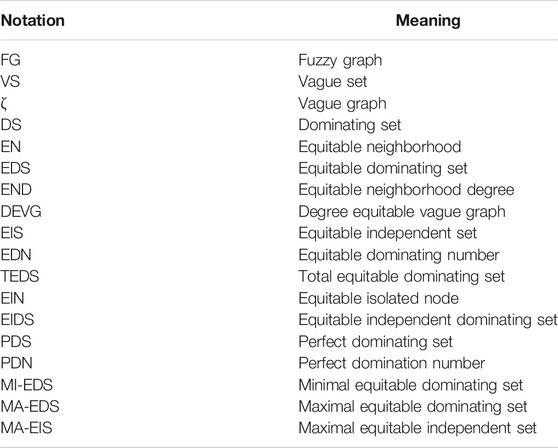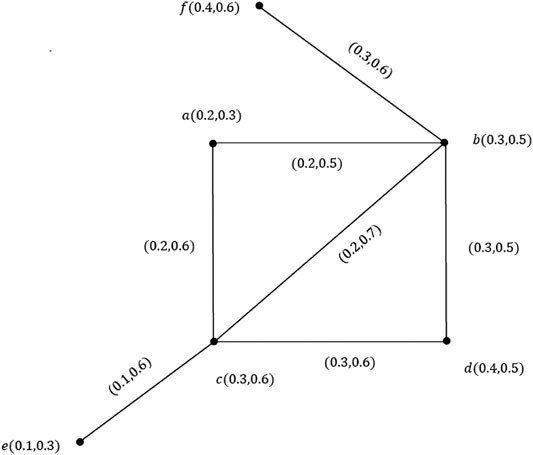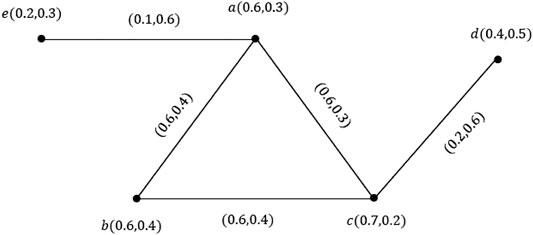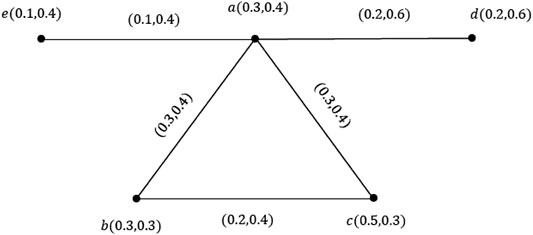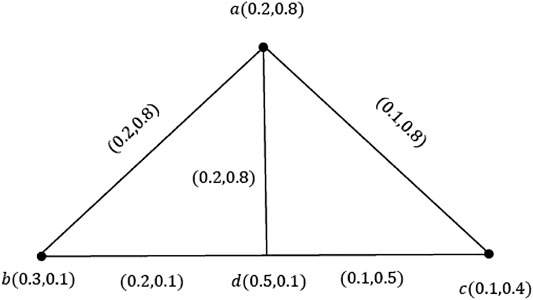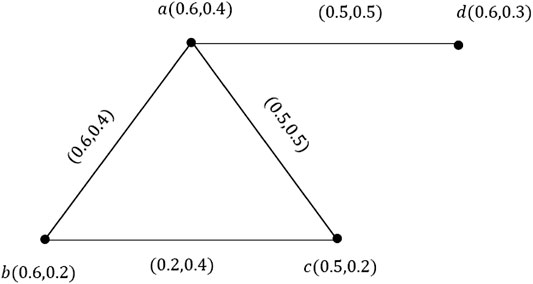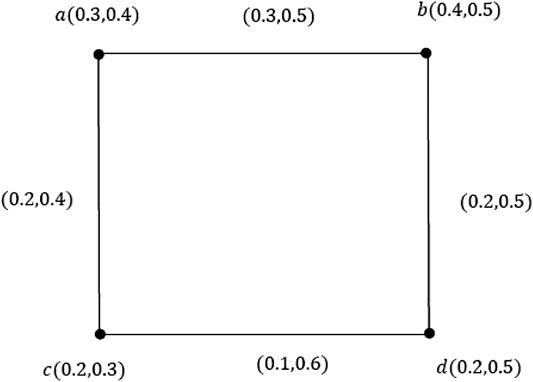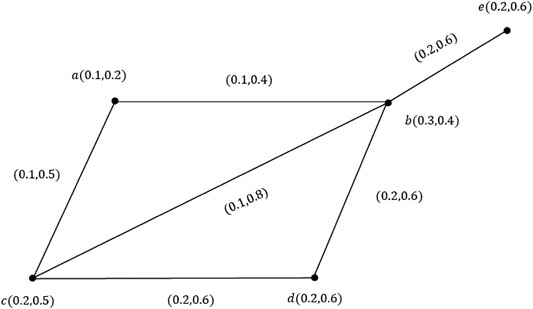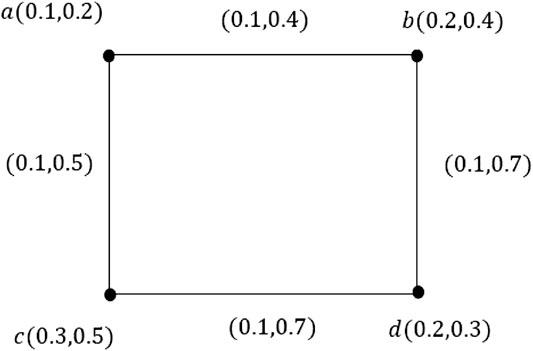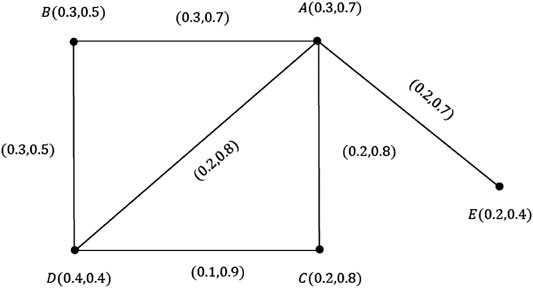- Institute of Computing Science and Technology, Guangzhou University, Guangzhou, China
Considering all physical, biological, and social systems, fuzzy graph (FG) models serve the elemental processes of all natural and artificial structures. As the indeterminate information is an essential real-life problem, which is mostly uncertain, modeling the problems based on FGs is highly demanding for an expert. Vague graphs (VGs) can manage the uncertainty relevant to the inconsistent and indeterminate information of all real-world problems, in which FGs possibly will not succeed in bringing about satisfactory results. In addition, VGs are a very useful tool to examine many issues such as networking, social systems, geometry, biology, clustering, medical science, and traffic plan. The previous definition restrictions in FGs have made us present new definitions in VGs. A wide range of applications has been attributed to the domination in graph theory for several fields such as facility location problems, school bus routing, modeling biological networks, and coding theory. Concepts from domination also exist in problems involving finding the set of representatives, in monitoring communication and electrical networks, and in land surveying (e.g., minimizing the number of places a surveyor must stand in order to take the height measurement for an entire region). Hence, in this article, we introduce different concepts of dominating, equitable dominating, total equitable dominating, weak (strong) equitable dominating, equitable independent, and perfect dominating sets in VGs and also investigate their properties by some examples. Finally, we present an application in medical sciences to show the importance of domination in VGs.
1 Introduction
Many real-world situations can accessibly be explained by means of a diagram consisting of a set of points together with lines joining certain pairs of these points. Notice that in such diagrams one is mainly interested in whether two given points are joined by a line; the manner in which they are joined is immaterial. A mathematical abstraction of situations of this type gives rise to the concept of a graph. To exemplify the objects and the connection between them, the graph nodes and edges are being employed accordingly. FGs are intended to demonstrate the connection structure among objects so that the concrete object existence (node) and the relationship between two objects (edge) are matters of degree. FG models are advantageous mathematical tools for addressing the combinatorial problems in several fields integrating research, algebra, computing, environmental science, and topology. Owing to the vagueness and ambiguity of natural existence, fuzzy graphical models outperform other graphical models. In 1965, Zadeh [44] proposed fuzzy set (FS) theory as a model for the exemplification of uncertainty and vagueness in real-world systems. FS theory is an exceedingly influential mathematical tool for resolving approximate reasoning-related problems. By defining the VS notion through changing the value of an element in a set with a subinterval of [0,1], Gau and Buehrer [13] introduced the VS theory. More probabilities are illustrated by VSs compared to FSs. A VS is more effective for explaining the false membership degree existence. Many events in the real world provided the incentive for introducing FGs. Kauffman [15] described FGs based on Zadeh’s fuzzy relation [44]. Kosari et al. [16] defined vague graph structure. Fuzzy Graph was introduced by Rosenfeld [32]. Akram et al. [1–6] proposed new definitions on FGs. Mordeson et al. [17–19] studied some results in FGs. Borzooie and Rashmanlou [7–11] analyzed several concepts of VGs. Samanta et al. [33–38] defined fuzzy competition graphs and some bipolar fuzzy graph results. Shao et al. [25, 26, 39–41] introduced new results in FGs and intuitionistic fuzzy graphs. Ramakrishna [24] presented VG concepts and examined their properties. Rashmanlou et al. [27–31] advanced new concepts in VGs.
A VG is a generalized structure of a FG that provides more exactness, adaptability, and compatibility to a system when matched with systems that run on FGs. In addition, a VG is capable of concentrating on determining the uncertainty coupled with the inconsistent and indeterminate information of any real-world problem, where FGs may not lead to adequate results. There exist an extensive array of applications for domination in graph theory in several fields such as school bus routing, facility location problems, and electrical networks. The domination idea was introduced first in the chessboard problem. In 1962, Ore [22] pioneered to apply the expression “domination” for undirected graphs. Somasundaram [42] presented the domination and independent domination in FGs. Gani and Chandrasekaran [20, 21] investigated the fuzzy-DS and independent-DS notion utilizing strong arcs. Cockayne [12] and Hedetniemi [14] described the independent and irredundance domination number in graphs. The domination concept in intuitionistic fuzzy graphs was examined by Parvathi and Thamizhendhi [23]. Talebi and Rashmanlou [43] studied new applications of domination in VGs. Domination in VGs has several uses in different fields. Hence, this study seeks to consider different concepts of dominating, equitable dominating, total equitable dominating, weak (strong) equitable dominating, equitable independent, and perfect dominating sets in VGs and investigate their properties by some examples.
Previously, many emergency patients died due to delays in transportation to the hospital; therefore, we introduce an application in the transportation system to show the importance of domination in VGs.
2 Preliminaries
In this section, to consider the stage for our analysis and to facilitate the following of our discussion, a brief overview of some of the basic definitions is introduced. A graph denotes a pair
An FG has the form of
Definition 2.1. [13] A VS A is a pair
Definition 2.2. [13] The support of a vague set
Definition 2.3. [24] A pair
Definition 2.4. [8] Let
Definition 2.5. [8] Let
and
Definition 2.6. [8] An edge
Definition 2.7. [8] Two nodes
Definition 2.8. [9] The degree of a node a in a VG ζ is defined as the sum of weights of edges incident to a. It is defined by
Definition 2.9. [8] Let
Definition 2.10. [8] A subset S of V is called a DS in ζ if for each
Definition 2.11. [8] If ζ is a VG, then the vertex cardinality of
All the basic notations are shown in Table 1.
3 Domination in VGs
Definition 3.1. Let
Definition 3.2. The END of a node
Example 3.3. Let
Definition 3.4. Let
Example 3.5.Consider a VG
Definition 3.6.Let ζ be a VG. A subset
Definition 3.7.An EDS S of a VG ζ is called a MI-EDS of ζ if for each node
Example 3.8.Consider a VG
Definition 3.9.Let
Example 3.10.Consider a VG ζ, as shown in Figure 4. Simple calculations show that ζ is a degree equitable VG.
Definition 3.11.A subset
Definition 3.12.An EIS I is called a MA-EIS of ζ if, for each node
Example 3.13. Consider a VG
Definition 3.14.Let
Definition 3.15.An EDS
Example 3.16.Consider the VG
Theorem 3.17.Let
Proof. Let ζ be a VG with minimal EDS S; then, for each node
If
If
Conversely, suppose that S is an EDS of a VG ζ and, for every node
Theorem 3.18.Let
Proof.According to definition, every weak (strong) EDS of a VG ζ is an EDS of ζ,
and
∎
Theorem 3.19.Let ζ be a VG without single nodes and S be a MI-EDS of ζ; then
Proof.Let ζ be a VG with MI-EDS S; then, for each node
Theorem 3.20. Let ζ be a VG with EIDS I; then I is both a MI-EDS and a MA-EIS of ζ. Conversely, any MA-EIS I of a VG ζ is an EIDS of ζ.
Proof. Let ζ be a VG with EIDS K; then, for each node
Theorem 3.21.A subset
Proof.Assume that K is both an EDS and an EIS of a VG ζ. Suppose that K is not a MA-EIS of ζ, then clearly there exists a node
Definition 3.22.A total-EDS (TEDS) of a VG
Definition 3.23.A TEDS S of a VG ζ is called a minimal TEDS if, for each node
Example 3.24.Consider a VG
Theorem 3.25.Let ζ be a VG with no isolated nodes; then
Proof.As each TEDS of a VG ζ is a total dominating set, so
Definition 3.26.Let
Definition 3.27.A PDS S of a VG ζ is called a minimal PDS if, for each
Example 3.28.Consider a VG
4 The Application of VDS in Medical Sciences
In the past, many emergency patients died due to the delays in transportation to the hospital, but today the number has dropped dramatically. Traffic problems in cities are one of the factors influencing this delay. In addition, the specialization of hospitals has meant that each patient must be transferred to the relevant hospital based on the main complaint, even though this specialized hospital is further away than other available hospitals. Therefore, in this study, we have tried to identify the nearest hospital based on distance, traffic load, and patient complaints. For this purpose, we consider four hospitals located in one city. We show hospitals as B, C, D, and E. In this vague graph, one vertex represents the patient’s home and other vertices are related to the hospitals in the city. The edges indicate the accumulation of cars in the city. (See Figure 9).
The node
The edge
After calculating the cardinality of
It is obvious that
5 Conclusion
Considering the precision, elasticity, and compatibility in a system, vague models outweigh the other FGs. The VG concept generally has a large variety of applications in different areas such as computer science, operation research, topology, and natural networks. Domination in graph theory has a wide range of applications in several fields such as facility location problems, school bus routing, and coding theory. Therefore, in this research, we described several concepts of dominating sets, ED, TED, weak (strong) ED, EISs, and PDS, in VGs and also studied their properties incorporating some basic examples. Finally, we introduced an application of domination in the transportation system. Future research will hold the investigation of new concepts of vague planer graphs, vague bridges, vague cycles, and vague competition graphs and represent their applications in medical sciences and social networks.
Data Availability Statement
The original contributions presented in the study are included in the article/Supplementary Material; further inquiries can be directed to the corresponding author.
Author Contributions
All authors have contributed equally to this work. All authors have read and agreed to the possible publication of the manuscript.
Funding
This work was supported by the National Key R&D Program of China (No. 2018YFB1005100).
Conflict of Interest
The authors declare that the research was conducted in the absence of any commercial or financial relationships that could be construed as a potential conflict of interest.
References
1. Akram M, Naz S. Energy of pythagorean fuzzy graphs with Applications. Mathematics (2018) 6:136. doi:10.3390/math6080136
2. Akram M, Sitara M. Certain concepts in intuitionistic neutrosophic graph structures. Information (2017) 8:154. doi:10.3390/info8040154
3. Akram M, Naz S, Smarandache F. Generalization of maximizing Deviation and TOPSIS Method for MADM in simplified neutrosophic hesitant fuzzy environment. Symmetry (2019) 11:1058. doi:10.3390/sym11081058
4. Akram M, Zafar F. Rough fuzzy digraphs with application. J Appl Math Comput (2019) 59:91–127. doi:10.1007/s12190-018-1171-2
5. Akram M, Dar JM, Naz S. Pythagorean Dombi fuzzy graphs. J Intell Fuzzy Syst (2020) 6:29–54. doi:10.1007/s40747-019-0109-0
6. Akram M, Sarwar M. Transversals of m-polar fuzzy hypergraphs with applications. J Intell Fuzzy Syst (2017) 33:351–64. doi:10.3233/jifs-161668
7. Borzooei RA, Rashmanlou H. Ring sum in product intuitionistic fuzzy graphs. J Adv Res Pure Math (2015) 7:16–31. doi:10.5373/jarpm.1971.021614
8. Borzooei RA, Rashmanlou H. Domination in vague graphs and its applications. J Intell Fuzzy Syst (2015) 29:1933–40. doi:10.3233/ifs-151671
9. Borzooei RA, Rashmanlou H. Degree of vertices in vague graphs. J Appl Math Inform (2015) 33:545–57. doi:10.14317/jami.2015.545
10. Borzooei RA, Rashmanlou H, Samanta S, Pal M. Regularity of vague graphs. J Intell Fuzzy Syst (2016) 30:3681–9. doi:10.3233/ifs-162114
11. Borzooei RA, Rashmanlou H, Samanta S, Pal M. A Study on fuzzy labeling graphs. J Intell Fuzzy Syst (2016) 6(30):3349–55. doi:10.3233/ifs-152082
12. Cockayne EJ, Favaron O, Payan C, Thomason AC. Contribution to the theory of domination and irredundance in graphs. Discret Math (1981) 33(3):249–58. doi:10.1016/0012-365x(81)90268-5
13. Gau WL, Buehrer DJ. Vague sets. IEEE Trans Syst Man Cybern (1993) 23:610–4. doi:10.1109/21.229476
14. Haynes TW, Hedetniemi S, Slater P. Fundamentals of domination in graphs. Boca Raton: CRC Press (2013).
15. Kaufmann A. Introduction a la Theorie des Sour-Ensembles Flous. Paris, France: Masson et Cie (1973).
16. Kosari S, Rao Y, Jiang H, Liu X, Wu P, Shao Z. Vague graph Structure with Application in medical diagnosis. Symmetry (2017) 12(10):15–82. doi:10.3390/sym12101582
17. Mordeson JN, Mathew S. Fuzzy end nodes in fuzzy incidence graphs. New Math Nat Comput (2017) 13(3):13–20. doi:10.1142/s1793005717500028
18. Mordeson JN, Mathew S. Human trafficking: source, transit, destination, designations. New Math Nat Comput (2017) 13(3):209–18. doi:10.1142/s1793005717400063
19. Mordeson JN, Mathew S, Borzooei RA. Vulnerability and government response to human trafficking: Vague fuzzy incidence graphs. New Math Nat Comput (2018) 14(2):203–19. doi:10.1142/s1793005718500138
20. Nagoorgani A, Mohamed SY, Hussain RJ. Point set domination of intuitionistic fuzzy graphs. Int J Fuzzy Math Archive (2015) 7(1):43–9. doi:10.1007/s12190-015-0952-0
21. Nagoorgani A, Chandrasekaran VT. Domination in fuzzy graphs. Adv Fuzzy Sets Syst (2006) I(1):17–26. doi:10.1007/s12190-015-0952-0
23. Parvathi R, Thamizhendhi G. Domination in intuitionistic fuzzy graph, proceedings of 14th international Conference on intuiyionistic fuzzy graphs. Notes Intuit Fuzzy Sets (2010) 16(2):39–49. doi:10.1007/3-540-34783-6_15
25. Rao Y, Kosari S, Shao Z. Certain Properties of vague Graphs with a novel application. Mathematics (2020) 8:16–47. doi:10.3390/math8101647
26. Rao Y, Kosari S, Shao Z, Cai R, Xinyue L. A Study on Domination in vague incidence graph and its application in medical sciences. Symmetry (2020) 12:18–85. doi:10.3390/sym12111885
27. Rashmanlou H, Borzooei RA. Vague graphs with application. J Intell Fuzzy Syst (2016) 30:3291–9. doi:10.3233/ifs-152077
28. Rashmanlou H, Samanta S, Pal M, Borzooei RA. A study on bipolar fuzzy graphs. Em J Intell Fuzzy Syst (2015) 28:571–80. doi:10.3233/ifs-141333
29. Rashmanlou H, Borzooei RA. Product vague graphs and its applications. J Intell Fuzzy Syst (2016) 30:371–82. doi:10.3233/ifs-152077
30. Rashmanlou H, Jun YB, Borzooei RA. More results on highly irregular bipolar fuzzy graphs. Ann Fuzzy Math Inform (2014) 8:149–68. doi:10.1007/978-981-15-8756-6_1
31. Rashmanlou H., Borzooei R.A., Shoaib M., Talebi Y., Taheri M., Mofidnakhaei F. New way for finding shortest path problem in a network. Multiple Valued Logic Soft Comput 20205451460. doi:10.1109/icnn.1993.298689
32. Rosenfeld A. In: LA Zadeh, KS Fu, and M Shimura, editors. Fuzzy graphs, fuzzy Sets and their applications. New York, NY, USA: Academic Press (1975). p. 77–95.
33. Samanta S, Pal M. Fuzzy k-competition graphs and pcompetition fuzzy graphs. Fuzzy Inf Eng (2013) 5:191–204. doi:10.1007/s12543-013-0140-6
34. Samanta S, Akram M, Pal M. m-step fuzzy competition graphs. J Appl Math Comput (2014) 11:133–9. doi:10.1007/s12190-s12014-s10785-s10782
35. Samanta S, Pal M. Irregular bipolar fuzzy graphs. Int J Appl Fuzzy Sets (2012) 2:91–102. doi:10.1109/tfuzz.2014.2387875
36. Samanta S, Pal M. Some more results on bipolar fuzzy sets and bipolar fuzzy intersection graphs. J Fuzzy Math (2014) 22:253–62. doi:10.14569/ijarai.2014.030109
37. Samanta S, Pal M, Rashmanlou H, Borzooei RA. Vague graphs and strengths. J Intell Fuzzy Syst (2016) 30(6):3675–80. doi:10.3233/ifs-162113
38. Sahoo S, Pal M, Rashmanlou H, Borzooei RA. Covering and paired domination in intuitionistic fuzzy graphs. J Intell Fuzzy Syst (2017) 33(6):4007–15. doi:10.3233/jifs-17848
39. Shao Z, Kosari S, Rashmanlou H, Shoaib M. New Concepts in intuitionistic fuzzy Graph with Application in water supplier systems. Mathematics (2020) 8:12–41. doi:10.3390/math8081241
40. Shao Z, Kosari S, Shoaib M, Rashmanlou H. Certain Concepts of vague graphs with Applications to Medical diagnosis. Front Phys (2020) 8:357. doi:10.3389/fphy.2020.00357
41. Shao Z, Li Z, Wu P, Chen L, Zhang X. Multi-factor combination Authentication using fuzzy graph domination model. J Intell Fuzzy Syst (2019) 37:4979–85. doi:10.3233/JIFS-181859
42. Somasundaram A, Somasundaram S. Domination in fuzzy graph-I. Patter Recogn Lett (1998) 19(9):787–91.doi:10.1016/S0167-8655(98)00064-6
43. Talebi Y, Rashmanlou H. New concepts of domination sets in vague graphs with applications. Int J Comput Sci Mathematics (2019) 10(4):375–89. doi:10.1504/ijcsm.2019.10024350
Keywords: vague set, vague graph, equitable dominating set, equitable neighborhood, medical science, Mathematics Subject Classification: 05C99, 03E72
Citation: Rao Y, Kosari S, Shao Z, Qiang X, Akhoundi M and Zhang X (2021) Equitable Domination in Vague Graphs With Application in Medical Sciences. Front. Phys. 9:635642. doi: 10.3389/fphy.2021.635642
Received: 30 November 2020; Accepted: 15 January 2021;
Published: 18 March 2021.
Edited by:
Jinjin Li, Shanghai Jiao Tong University, ChinaReviewed by:
Veena Mathad, University of Mysore, IndiaHossein Rashmanlou, University of Mazandaran, Iran
Copyright © 2021 Rao, Kosari, Shao, Qiang, Akhoundi and Zhang. This is an open-access article distributed under the terms of the Creative Commons Attribution License (CC BY). The use, distribution or reproduction in other forums is permitted, provided the original author(s) and the copyright owner(s) are credited and that the original publication in this journal is cited, in accordance with accepted academic practice. No use, distribution or reproduction is permitted which does not comply with these terms.
*Correspondence: Saeed Kosari, c2FlZWRrb3NhcmkzOEBnemh1LmVkdS5jbg==
 Yongsheng Rao
Yongsheng Rao Saeed Kosari
Saeed Kosari Zehui Shao
Zehui Shao Xiaoli Qiang
Xiaoli Qiang Maryam Akhoundi
Maryam Akhoundi Xiao Zhang
Xiao Zhang